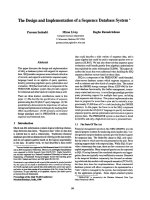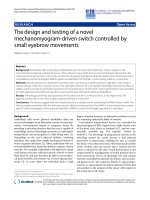The design and fabricate a pulse shape discriminator apply signal processing method using EJ-301 detector
Bạn đang xem bản rút gọn của tài liệu. Xem và tải ngay bản đầy đủ của tài liệu tại đây (3.51 MB, 5 trang )
Nuclear Science and Technology, Vol.7, No. 2 (2017), pp. 51-55
The design and fabricate a pulse shape discriminator apply
signal processing method using EJ-301 detector
Dang Hong Ngoc Quy1, Pham Ngoc Tuan1, Tuong Thi Thu Huong1,
Phan Van Chuan2 and Nguyen Nhi Dien2
1
Nuclear Research Institute, 01 Nguyen Tu Luc, Dalat, Lam Dong
2
Dalat university, 01 Phu Dong Thien Vuong, Lam Dong
Email:
(Received 03 October 2017, accepted 05 December 2017)
Abstract: The high quality measurements of neutron energy spectra are required in various fields of
research and applications. However, in many cases the contribution of gamma background causes the
inaccuracy of neutron spectrum. Therefore, the discrimination of gamma-ray events in neutron
spectrum is necessary. In this article, an algorithm for digital implementation of the chargecomparison method for n/γ discrimination based on Digital Signal Processing technique is described.
Furthermore, the APX-500 board was used as a hardware for the development of a Pulse Shape
Disciminator, and is equipped with ADC ADM-414 14 bit-100 MSPS. The fully system has been tested
with EJ-301 detector, using 252Cf neutron source.
Keywords: Pulse Shaping Discriminator (PSD), Digital Signal Processing (DSP), EJ-301 scintillator.
I. INTRODUCTION
There are usually three sources of background noise in neutron detection: alpha
particles, beta particles, and high-energy
photons (γ-rays). Alpha and beta particles can
be easily shielded by various materials.
However, γ-rays pass through physical barriers
and when mixed with neutrons in the detection
environment, they behave almost the same as
neutrons and make it uncertain whether
neutrons are detected or γ–rays [1]. Therefore,
various methods of separating the neutrons from
the gammas have been developed, including
both analog and digital approaches such as zero
crossing, constant fraction discriminator [2,3],
charge comparison [3,4], frequency gradient
analysis [5], rise time discrimination, pattern
recognition [6], etc.
In this work, charge comparison is carried
out and established to develop an optimum
algorithm for Pulse Shape Discriminator (PSD)
based on the different interactions between
gamma and neutron rays with the material of
detectors. A PSD module is designed and
fabricated based on Digital Signal Processing
(DSP) technique and Field Programmable Gate
Arrays (FPGA) devices.
In the recent period at NRI, most of the
radiation
measurements
have
been
digitalized, such as Digital Multichannel
Analyzer
(DMCA),
coincidence
measurement
system.
However,
the
application of digital signal processing
techniques to discriminate pulses have not
been studied so far. Novel DSP methods are
introduced and studied in this work.
II. CONTENTS
A. Subjects and Methods
This method shows that gamma-ray
pulses have shorter tails than neutron pulses
when interacting with the material of detectors
and the ratio of these pulses will be
approximately constant for pulses of common
©2017 Vietnam Atomic Energy Society and Vietnam Atomic Energy Institute
THE DESIGN AND FABRICATE A PULSE SHAPE DISCRIMINATOR APPLY SIGNAL …
shape, independent of pulse amplitude [1]. An
approach to the design is based on independent
measurements of the integrated charge over two
different time regions of the pulse.
The ratio of tail-to-total integrals is
calculated as follow:
histogram of the Qratio versus peak height data.
The FOM is defined as in figure 2 (note that this
definition assumes that the pulse distributions
are Gaussian):
(2)
Where as:
(1)
Chn , Ch are the values of neutron and
gamma peaks respectively; FWHM n , FWHM
are the full-width-half-maximum of neutron and
gamma peaks, respectively.
Fig.1. Illustration of the pulse shape from detector.
The time intervals over which the total
and tail integrals are calculated, these
parameters can be modified to increase the
performance of the PSD method.
From the figure 1, the total integral (A1)
and tail integral (A2) are computed for each
pulse and used for classification as a neutron or
gamma-ray. Pulse timing was achieved by
measuring the time at which the pulse reaches
20% of the pulse amplitude.
T1start is the starting point of the total
integral (A1) and T2start is the starting point of
the tail integral (A2) and Tend is the ending point
of both. The timing for T2start and Tend are
decided empirically based on a specific detector
used to achieve optimal results. Since pulses for
heavy particles have a larger fraction of light in
the tail, a larger ratio of tail-to-total will be
obtained for neutrons compared to gamma rays.
Fig. 2. Derivation of the figure of merit (FOM)
B. Results
The design and implementation of the
digital pulse shape discriminator is shown in
figure 3.
a
b
N
COMPARE Thr
RC- (CR)N
MONO
STABLE
N = 1;2
TRIGGER
MAKE AREA TWO REGION
ADC
SAMPLES
FIFO
LONG TAIL AREA
PROCESSOR
DELAY
READY
SEARCH
PEAK
The QRatio (R) for neutron pulses should
be larger than the QRatio(R) for gamma ray
pulses for the same total charge deposited. The
figures of merits (FOM) is calculated from the
TRIGGER
THRESHOLDS
START1
START2
KCPSM6
UART
SHORT TAIL AREA
PROCESSOR
STOP
Fig. 3. The block diagram of Digital Pulse Shape
Discriminator.
52
PC
DANG HONG NGOC QUY et al.
From this method is mentioned above, the
Digital Pulse Shape Discriminator was
fabricated. This system consists of the various
component modules. All components have been
designed, implemented using digital signal
processing technique.
The installation of the measurement
configuration in order to test the algorithm for
PSD is shown in figure 4.
Detector
High technology development has created
a variety of techniques such as flash analog
digital convertor (ADC), FPGA, and dedicated
DSP circuits. That makes the PSD based on
digital signal processing technique widely
applied. In modern DSP-based PSD systems,
pulses from the detector are digitized by the fast
sample ADC named ADM-414, the sample rate
is 400 MSPS. The output from the ADC are
then stored in the FIFO and analyzed by the
PSD system to give the A1 and A2. The
Pre-Amp
ADM414
APX
500
PCI
EXP
Soft
ware
and
PC
HV
Fig.4. The set up of PSD system
Specifications:
+ ADC: ADM414-14bits, the sample rate
is 400 MSps;
+ HV: +1200V
+ Sampling mode: stream mode;
application software tools for the control of
the instrument, data acquisition and
processing was written under C++ builder
program.
+ Captured data: Channel 1.
In this experiment, the value of 3
thresholds are decided as follows:
+ T1start: 20% of peak value
+ T2start: 50% of peak value
+ Tstop: 5% of peak value
Typical pulse from pre-amplifier of EJ301 detector are shown in figure 5.
The total integral of the input pulse A1 is
given by long tail area processor module while
the short integral of the input pulse A2 is given
by short tail area processor module.
Fig. 5. The pulses are collected from ADM-414 board in “Stream mode”.
53
THE DESIGN AND FABRICATE A PULSE SHAPE DISCRIMINATOR APPLY SIGNAL …
Fig. 6. The output pulse from CR-(RC)N network
The quantities of n-γ discrimination is
shown with FOM and neutron peak -to- valley
ratio.
reduce noise and create a trigger. After that, this
trigger signal is used to initialize all components
in system in figure 6. The blue pulse is input
pulse from ADC. The red pulse is transferred
CR-(RC)N filter. The value of N is 2.
The output pulses of RC-(CR)N filter is
compared with adjustable threshold in order to
Fig 7. The FOM of PSD system
System is tested with 252Cf, the final
result of PSD are presented in Fig 7. The data
are smoothed by moving average filter (MA).
FOM is calculated around 1.
C. Discussion
The sampling rate of the PSD is 400 MHz
and that give a time resolution of 2.5 ns.
54
DANG HONG NGOC QUY et al.
[5]. G. Liu, M. J. Joyce, X. Ma, and M. D. Aspinall,
“A digital method for the discrimination of
neutrons and rays with organic scintillation
detectors using frequency gradient analysis,”
Nucl. Sci. IEEE Trans., vol. 57, no. 3, pp. 1682–
1691, 2010.
Therefore, the data points can catch the entire
structure of the pulse. However, to improve the
resolution and give better FOM, the GHz
sampling rate ADC should be used.
Recommendation for further research,
the possibility of pulse shape analysis to
separate gamma rays and neutrons for organic
scintillation detectors will be conducted
carefully, other neutron sources should be
studied such as Am-Be, thermal neutrons from
nuclear reactors. The pie-up rejection will be
carried out and designed in the near future.
[6]. Takaku, D., Oishi, T. & Baba, M. (2011).
Development of neutron-gamma discrimination
technique using pattern-recognition method
with digital signal processing. Nuclear Science
and Technology, 1, 210-213.
III. CONCLUSIONS
In this research, digital-pulse processing
algorithm for discrimination of neutrons and γ
rays in EJ-301 detector has been developed. In
conclusion, the system has been designed and
fabricated successfully with the peak-to-valleyratio is 10 and FOM is larger than 1, enough to
separate gamma rays and neutrons from the Cf252 neutron sources.
REFERENCES
[1].
Moslem
Amiri,
Neutron/gamma-ray
measurement and discrimination, PhD thesis,
2014.
[2]. M. L. Roush, M. A. Wilson, and W. F. Hornyak,
“Pulse shape discrimination,” Nucl. Instruments
Methods, vol. 31, no. 1, pp. 112–124, 1964.
[3]. E. Bayat, N. Divani-Vais, M. M. Firoozabadi,
and N. Ghal-Eh, “A comparative study on
neutron-gamma discrimination with NE213 and
UGLLT scintillators using zero-crossing
method,” Radiat.
Phys. Chem., vol. 81, no. 3, pp. 217–220, 2012.
[4]. J. Cerny, Z. Dolezal, M. P. Ivanov, E. S.
Kuzmin, J. Svejda, and I. Wilhelm, “Study of
neutron response and n--γ discrimination by
charge comparison method for small liquid
scintillation detector,” Nucl. Instruments
Methods Phys. Res. Sect. A Accel.
Spectrometers, Detect. Assoc. Equip., vol. 527,
no. 3, pp. 512–518, 2004.
55









